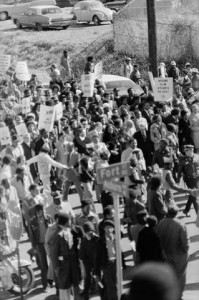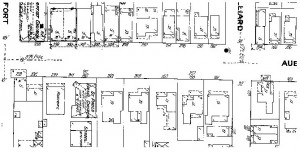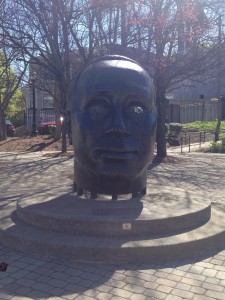Talking a walk down Auburn Avenue is an experience that many Atlanta residents and tourists have enjoyed. When walking down Auburn, it is easy to be taken aback by how beautiful the birth home of Dr. King is. It is easy for residents and tourist to stop and admire the burial site of Dr. King and his wife Coretta Scott King. Tourists and residents are blown away when they view the massive mural of civil rights leader and congressman John Lewis. With all of these civil rights giants in one small street it is easy to understand why the John Wesley Dobbs Plaza on the corner of Auburn and Fort Street does not get much attention. Hundreds of people drive or walk pass the plaza on a daily basis and yet one does not find many people stepping inside the plaza and admiring the statue of John Wesley Dobbs. The plaza is overshadowed by the presence of Dr. King’s historical site and John Lewis’ mural, which is an appropriate metaphor as to how the legacy of Mr. Dobbs has been largely forgotten by the mainstream public.
Even though many people in the public do not know who John Wesley Dobbs was the sculpture and plaza still remain. One might ask why does this man that nobody seems to know deserve a statue in the middle of a street that commemorates civil rights legends? Dobbs was born in Marietta in 1882.[1] He spent most of childhood in Kennesaw living with his grandparents, in a rural and poor community. [2] When Dobbs was older he would describe how poor he was by telling the story of how he would wait by the railroad tracks so that passengers would throw banana peels out the window. Once Dobbs saw the banana peels on the floor he would proceed to pick them up and eat them. This story alone illustrates just how deep in poverty John Wesley Dobbs was at the beginning of his life. He was a very bright child but was almost forced to drop out after the fifth grade because of his family’s financial struggles. He eventually found a job that let him continue his education.
At the age of fifteen Dobbs moved to the city of Atlanta.[3] He would continue to be in school, but would eventually have to drop out because he had to take care of his mother in her time of sickness. He never earned a degree but he read a lot and later on in his life he made sure that all six of his daughters graduated from Spellman College.[4] In the year 1911 Dobbs joined the Prince Hall Masons, which was a black fraternal organization, founded for social purposes. Dobbs really enjoyed being part of the masonic fraternal organization. He became the Grand Warden of the Masons in Atlanta in 1914. The Masons would meet up on Auburn Avenue, which would become the neighborhood that Dobbs did most of his civil rights work in. He would later coin the phrase “Sweet Auburn” and was referred to by many as the mayor of Auburn Avenue.[5] Dobbs had such affection for the people of Auburn Avenue that when he traveled abroad to other countries he would write a letter to the residents of the neighborhood.[6] The letter he wrote to the people of Auburn Avenue shows that his voice was important enough for his letters to be published in the Atlanta Daily World and it also shows how intimate a relationship Dobbs had with the people of Auburn Avenue because he keeps referring to them as his “friends”.
One of Dobbs’ largest civil rights accomplishments was the role that he played in getting black Atlanta voters out to the polls. He was known to give fiery speeches that would inspire crowds to register to vote. Dobbs was a proponent of black suffrage and in the year 1946 he cofounded the Atlanta Negro Voter League.[7] This was a large accomplishment because black voters of Atlanta could organize and vote as a block for the candidate that would be best for the black community of Atlanta. Dobbs also played a vital role in getting the first black police officers hired in the city of Atlanta. He was able to accomplish this by putting pressure on Mayor Hartsfield to deliver on his promise to black voters to hire black police officers.[8] Dobbs’ health would eventually start to decline. He died on August 30 1961. His legacy lived on with his grandson Maynard Jackson becoming the first black mayor of Atlanta. In 1994 Houston street would be renamed John Wesley Dobbs Avenue, “in recognition of the late Prince Hall Masonic leader’s civic and political contribution to the city and state”.[9] In 1996 The John Wesley Dobbs plaza was designed to commemorate John Wesley Dobbs’ life and legacy.
The John Wesley Dobbs plaza is located on the corner of Auburn Avenue and Fort Street. The plaza has obviously not been there forever. The building that took the corner of Auburn and Fort Street was the St. Paul Episcopal Church.[10] According to the St. Paul Episcopal Church website the Auburn avenue location was opened up in the year 1895.[11] In the year 1917 there was a large fire that went through Decatur Street, Edgewood Avenue, Auburn Avenue and Fort Street.[12] The St. Paul Episcopal Church was burned to the ground. The church was rebuilt in the year 1924 on the corner of Auburn Avenue and Fort Street.[13] The church kept growing in large numbers and in the year 1969 the church moved to a new location leaving the corner of Auburn Avenue and Fort Street completely vacant.

Martin Luther King, Jr. Birthday Observance. Atlanta, Georgia, January 15 1976, VIS 101.472.016. Boyd Lewis Photographs.
The corner of Auburn Avenue and Fort Street continued to be vacant for several years. Evidence of the vacancy can be seen by analyzing a photograph of a group of people marching on Auburn and Fort commemorating the life of Martin Luther King Jr on what would have been his 47th birthday.[14] The vacancy of Auburn Avenue and Fort Street would not exist for ling because in 1996 the Cooperation for Olympic Development in Atlanta sponsored and opened up John Wesley Dobbs Plaza on the corner of.[15] The unveiling of the plaza was a large event, which shows just how influential and important Dobbs was on the history of the city. The mayor at the time Bill Cambell spoke at the unveiling. The former mayor and grandson of Dobbs, Maynard Jackson was also present at the event. The plaza features a seven-foot high bronze sculpture that lets tourist and residents look at Auburn Avenue through the eyes of John Wesley Dobbs.
There are not many tourists that admire the statue or that stand behind the sculpture to look at Auburn through the eyes of Dobbs. Instead the Plaza has become a fairly popular loitering spot for the homeless. Many homeless people sit on the benches provided by the city for hours on end. The plaza still catches the eyes of many people driving through it. One might witness a tourist ask “Is that statue Martin Luther King?” which shows just how much the public is aware of who Dobbs was and why there is a plaza dedicated to him. But there is hope for the plaza to be the historical attraction that it was meant to be for a variety of reasons. For example the name of the streetcar stop on Auburn Avenue is called “Dobbs Plaza” which should cause some awareness for the general public as to who the plaza is dedicated to. With the rise of historical curiosity in the city of Atlanta one can have hope that the John Wesley Dobbs plaza will start to play a larger role in the conversation of historic landmarks in the city.
[1] “John Wesley Dobbs (1882-1961).” New Georgia Encyclopedia. 24 December 2014. Web. Accessed. 05 April 2016.
[2] Where Peachtree meets Sweet Auburn: the saga of two families and the making of Atlanta. New York: Scribner, 1996. p. 63
[3] Ibid
[4] Charlene P Smith Williams. “The Dobbses: A Tradition of Politics and Education.” The Atlanta Constitution (1946-1984), Dec 11, 1979. P.3
[5] “John Wesley Dobbs (1882-1961).” New Georgia Encyclopedia. 24 December 2014. Web. 05 April 2016.
[6] “John Wesley Dobbs Writes to “Sweet Auburn Ave. Friends”.”Atlanta Daily World (1932-2003), Mar 20, 1952.
[7] New York: Scribner, 1996. P 184.
[8] New York: Scribner, 1996. P 161-162.
[9] Street renaming ceremony honors late pioneer john Wesley Dobbs. Atlanta Daily World (1932-2003), Jan 13, 1994. P 1.
[10] Corner of Auburn and Fort, Atlanta 1911-1925, sheet 156, Sanborn Fire Insurance Maps.
[11] St Pauls Episcopal Church Atlanta http://stpaulsatl.org/?page_id=28
[12] Atlanta and Its Environs. Athens: University of Georgia Press, 1954. P 701
[13] St Pauls Episcopal Church Atlanta http://stpaulsatl.org/?page_id=28
[14] Martin Luther King, Jr. Birthday Observance. Atlanta, Georgia, January 15 1976, VIS 101.472.016. Boyd Lewis Photographs.
[15] “Dobbs Memorial Unveiled by Mayor on Auburn Ave.”Atlanta Daily World (1932-2003), Jul 07, 1996. P 1.



